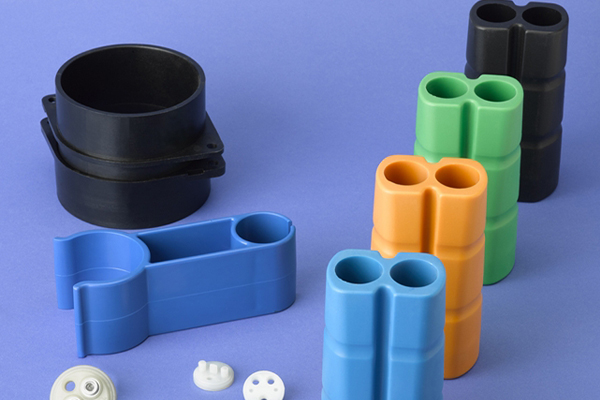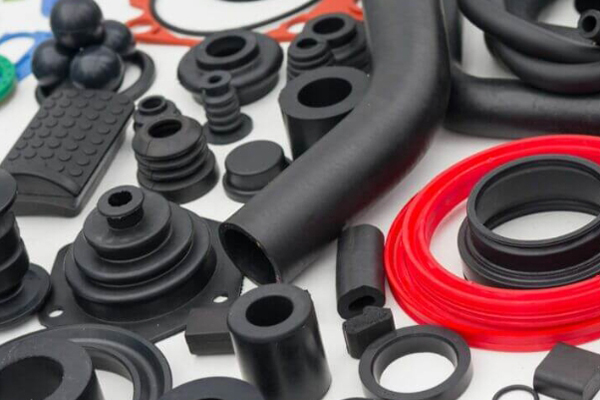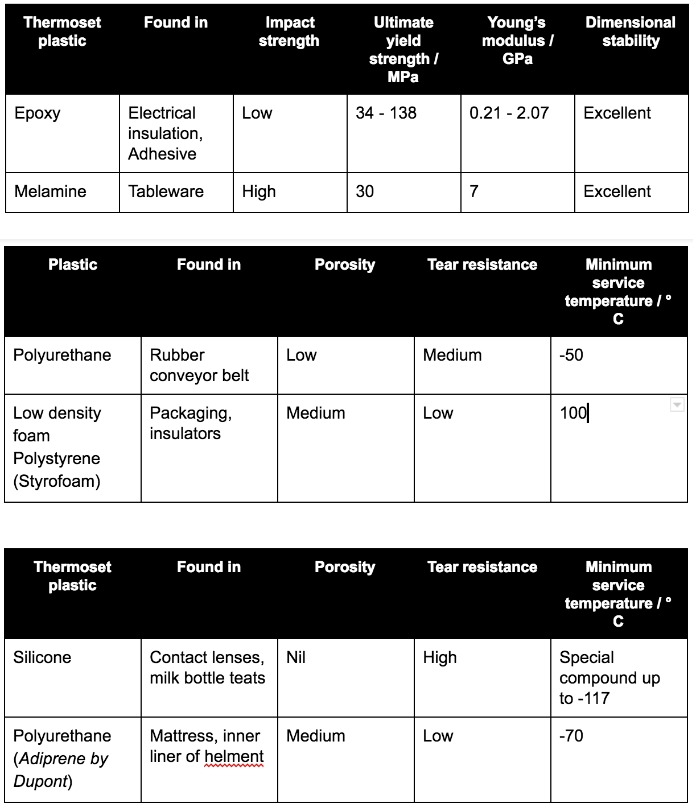Thermoplastics vs Thermoset Plastics to Create Custom Parts
Classes of polymers called thermoplastics and thermoset plastics are utilized in urethane casting, CNC machining, injection molding, and 3D printing. Thermoplastics and thermosets are composed of long, repeating chains of molecules, just like elastomers, another class of polymers. The structure of a thermoset material appears like a honeycomb under a microscope, whereas that of a thermoplastic is similar to a railroad track. Greater viscosity and elasticity are provided by the spaghetti-like strands that make up the less ordered structures of elastomers.
Although molecules are not as important to product designers as material qualities are, a polymer’s processing and performance are influenced by its strand structure. The way thermoplastics and thermoset polymers behave when heated is, in general, their primary distinction. While thermoset materials cannot be remelted and reused, thermoplastics can. But these aren’t the only distinctions between them.
For Thermoplastics:
Less Heat Resistance, Less Chemicals Resistance, Less Deformation (Creep) Resistance
More Impact Resistance, More Shattering Resistance
For Thermosets:
More Heat Resistance, More Chemicals Resistance, More Deformation (Creep) Resistance
Less Impact Resistance, Less Shattering Resistance
There are hundreds of distinct thermoplastics and thermosets, each with unique material attributes including plastic strain rate and service temperature, thus these variations are common rather than universal. It’s crucial to know if a polymer is thermoset or thermoplastic, but designers also need to take into account the benefits and drawbacks of each class of polymer, as well as its various classifications, uses, and typical materials.


Advantages and Limitations of Thermoplastics in Injection Molding
Thermoplastics offer several advantages in injection molding, thanks to their unique properties. They can be heated, cooled, reheated, and recycled, making them an excellent choice for various manufacturing processes. In injection molding, solid resin pellets are heated to their melting point, allowing the liquid material to enter the mold, cool, and solidify. The excess thermoplastic material from the runner, a channel guiding plastic flow into the mold cavity, can be recycled, optimizing material utilization. Additionally, thermoplastics lend themselves to surface finishing, supporting their application not only in injection molding but also in CNC machining and 3D printing.
One noteworthy advantage is the recyclability of thermoplastic materials. In the context of injection molding, thermoplastics can be ground into pellets and re-melted for subsequent use. It’s important to note that these recycled plastics, known as non-virgin plastics, may not maintain their original properties indefinitely, and the number of times a thermoplastic can be recycled varies depending on the specific material.
However, there are limitations to consider. In injection molding, thermoplastics are more susceptible to flash formation due to their higher viscosities. Like any prototyping or manufacturing process, subjecting thermoplastics to elevated temperatures can result in softening or melting of these materials. Understanding these advantages and limitations is essential when working with thermoplastics in injection molding.
Thermoplastics: Categories, Applications, and Examples
Thermoplastics represent one of the three major classes of polymers, with further categorization into two primary types, each characterized by distinct material properties determined by their molecular structure.
Amorphous thermoplastics feature a less ordered (amorphous) structure. While they exhibit lower heat resistance, they display toughness at lower temperatures. In some instances, these materials maintain clarity.
Semi-crystalline thermoplastics possess a more organized (crystallite) structure with some amorphous regions. These thermoplastics offer superior heat and chemical resistance, increased strength, and enhanced stability.
In terms of applications, thermoplastics find utility in consumer goods, as well as commercial and industrial settings. Here are a few examples of thermoplastic products:
- Toys and toothbrushes
- Storage containers
- Water bottles
- Windows and lighting fixtures
- Packaging materials
- Automotive components
- Gear wheels
Numerous thermoplastics exist, but the following materials are commonly used:
- Acrylonitrile butadiene styrene (ABS)
- Nylon (polyamide, PA)
- Polyethylene terephthalate (PET)
- Polypropylene (PP)
- Polystyrene (PS)
- Polyvinyl chloride (PVC)
- Thermoplastic elastomer (TPE)
Thermoset Plastics: Advantages and Disadvantages
Thermoset plastics are employed in various processes, including injection molding, CNC machining, 3D printing, and urethane casting that utilizes two-part epoxy materials. In the case of thermosetting resins, a chemical reaction leads to a phase change into a solid state. While heat may result from this process, it is not the primary driver of the chemical cross-linking that bonds molecules together. The significant processing distinctions between thermosets and thermoplastics must be noted, as thermoset materials cannot be reshaped or reformed once they solidify.
Thermosets exhibit higher heat resistance and offer superior corrosion resistance compared to thermoplastics. They also provide greater resistance to creep, which is the tendency of a solid material to permanently deform under mechanical stress. The physical and mechanical strength of thermosets make them suitable for many applications, but trade-offs must be considered by designers.
The main drawback of thermosets is their inability to be reheated for reprocessing. They tend to be more rigid than thermoplastics, have lower impact resistance, and are more prone to shattering. The disposal of thermosets is more challenging, although some materials can be ground into filler materials. In contrast to thermoplastics, thermosets are more challenging to surface finish, and their increased hardness and brittleness make them more difficult to machine. During injection molding, it is essential to prevent a thermoset from reaching its cross-linking temperature until the plastic enters the mold.
Thermoset Plastics: Categories, Applications, and Examples
Thermoset resins constitute a polymer class further classified into distinct categories:
- Amino resins
- Epoxy resins
- Phenolic resins
- Polyester resins
- Polyurethanes
- Silicone resins
Plastic resins, unprocessed polymer-based materials, including thermoset resins, predominantly derive from byproducts of petroleum refinement. In thermoset injection molding, these resins are typically provided in liquid form, necessitating distinct equipment and procedures compared to their solid counterparts.
Thermoset plastics find application in various consumer, commercial, and industrial settings. Some illustrative examples of thermoset products encompass:
- Electronic components
- High voltage insulators
- Heat shields
- Motor components and covers
- Lighting components
- Energy equipment
- Medical instruments, such as dental tools with overmolded handles, which benefit from the autoclavable properties of thermoset plastics under high temperatures and pressures.
Numerous types of thermosets exist, but the following materials are commonly utilized:
- Alkyds
- Epoxy
- Melamine
- Phenolic
- Polyimides
- Polyurethane
- Silicone
- Thermoset polyester
Charts provided below outline typical applications and key specifications for various thermoset plastics. For epoxy and melamine, strength and stability are paramount due to the demanding environmental conditions in which they are commonly employed. In contrast, polyurethane, silicone, and polystyrene, representing three other thermosetting plastics, prioritize attributes such as porosity, tear resistance, and minimum service temperature to meet a diverse range of requirements.

Materials Selection at Sungplastic
Comparing thermoplastics and thermoset plastics offers a high-level understanding of the variations in polymer-based materials. But there are hundreds of distinct kinds of thermosets and thermoplastics, and every kind of material you choose has unique characteristics. Choosing a plastic can be made easier with the guidance of an expert because there are numerous possibilities.
We offer bespoke manufacturing, and no matter where you are in the design process, we can help your next injection molding project succeed because we have the tools, expertise, and smart manufacturing lines to support you. We can quickly obtain your samples, provide sound design of manufacturing (DFM) guidance, and assist you in selecting the appropriate material. In every case, we facilitate customized unique prototypes and design optimization.
Ready to conduct your next project? We’re always here to be your trustable partner.
Get a free quote and design analysis today.
We’ll reply to you within 6 working hours.
We respect your privacy.
+86 139 2927 4777 (WhatsApp, Wechat)
